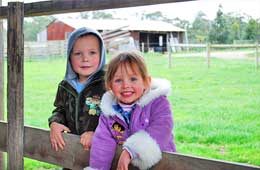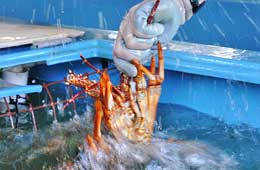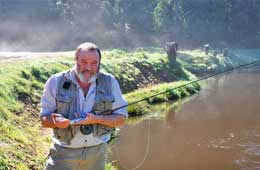Town and Country Farmer magazine
DIANNE and Ron Moore’s free-range egg laying hens thrive in a serene, natural environment on their Labertouche farm in Gippsland. The few black trees that line their driveway however, are a grim reminder of the trauma they went through to save their home, their animals and their livelihood during the Black Saturday Bushfires.
With assistance from the community, the couple have bounced back and their business is again successful. Remembering the kindness they received from others that came to help them in the wake of the fires, is still emotional for them and reduces Ron Moore to tears.
Dianne and Ron moved from the city 16 years ago when they purchased the eight-hectare farm for free-range egg production during their retirement years. After battling the local council, the Environment Protection Authority and the neighbours for two years, they finally gained a permit with many varying restrictions. “A lot of people were against us,” Ron said, “because they had the wrong idea about poultry farms and the conditions they put on us were unbelievable.”
The Moores now have a permit for 1400 birds but find 800 to 1000 suits them. From 600 laying hens they produce 200 dozen eggs a week. All the birds are Isa Brown because Dianne likes them. “They’re nice chooks,” she said. “They’re friendly, they lay well and they lay big eggs.”
They sell their wonderful produce at city farmer’s markets under their label ‘Moore Brown Free-range Eggs’. Ron said the farmer’s markets are the biggest saviour for them and other small producers, and they go to one every Saturday. “We take every egg laid up until Friday night and we usually sell out about half an hour before the market ends.”
The first eggs are laid a little after dawn, and Ron goes out with Henry their pet Maremma dog to collect them. The hens then wonder over a two-hectare paddock with a well-established forest that Ron and Dianne have created in the centre. They roam in and around the trees and bushes, and bath in the natural dust underneath them, which keeps them free of lice. They scramble up logs in the forest to perch during the day and come out to eat at the feed hoppers in the paddock. They stroll into the sheds for water, to lay their eggs, and to roost at night. Electric fence netting borders this chicken Shangrila to keep them safe from predators.
Three times a year, Ron and Dianne purchase 230 day-old chicks from a commercial hatchery and raise them in a shed that they have elsewhere on the farm. When the birds reach 16 weeks, they put 200 out with the others and sell the surplus to backyard producers that want point-of-lay pullets. Dianne said people with backyard chooks also buy the older hens that they pass on as first year of lay, for five dollars each. They are about 80 weeks old and they will still lay for another three years but the eggs get too big and the shell becomes too fragile for commercial production.
The five operating sheds each hold 200 birds. They are transportable and Ron moves them with a tractor, but no more than 10-15 metres at a time. “If we do the chooks stand around at dusk wondering where they’ve gone and yet they will go miles around the place during the day,” he said.
Inside the shed, they have perches and colony nesting boxes, which are long bench type boxes. “If we have individual nesting boxes, they tend to fight a bit and they all want to get into the same one,” Ron said. “We use wood shavings for nesting because if we use anything else, particularly rice hulls or anything that might have been a food at one stage, they will play in it for hours and make a mess.”
The feed is a natural vegetarian mix and their water is collected on the roof of the sheds and runs into a tank on each one. For backup, they have hoses connected to a mains water supply. They have a spray on each shed to keep the birds cool on a hot day so they don’t become distressed and Ron said it saved them through the fires.
“The chooks aren’t locked up,’ he said. “They let themselves out and they put themselves to bed. I just check the electric fence.”
During the fires, Ron and Dianne lost many trees, boundary fences, stockyards, the all-important electric fence and amazingly only four chooks. “When the fence was burnt we couldn’t protect the chooks from foxes,” Ron said, “and we found 54 headless bodies. I rang the local fencing agent and he sent out a complete pallet of new fencing for us later that week which was air freighted from America.
“Without electricity, we couldn’t keep the eggs in the cool shed, so for five days we donated them all hand-cleaned and inspected each morning to some local charities.
“The night before the fire, we were warned and well briefed by the CFA and the police at the Labertouche Hall. There was a fire in the ranges that they couldn’t put out and we could see it smouldering. Then at about 2.30 on Saturday, the wind came up and the fire came through the farm half an hour later. It burnt several houses behind us and then at about 5 o’clock the wind changed again and it came back like a big wall. We had sprinklers going on everything but there was a lot of thick smoke and flames and we thought the chooks were all gone.”
“We were prepared,” Dianne said, “but I never expected it, even after the briefing. We would have gone if we hadn’t had Henry and the chooks but they rely on us, so we couldn’t just walk out and leave them.”
“It was a learning experience,” Ron said. “Since then we have built a cellar for shelter because we know we won’t leave our animals.”
By Wendy Morriss (formerly Thompson)
Copyright © 2012 Wendy Morriss: Freelance Journalist. All Rights Reserved.





